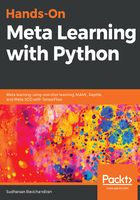
Meta learning
Meta learning is an exhilarating research domain in the field of AI right now. With plenty of research papers and advancements, meta learning is clearly making a major breakthrough in AI. Before getting into meta learning, let's see how our current AI model works.
Deep learning has progressed rapidly in recent years with great algorithms such as generative adversarial networks and capsule networks. But the problem with deep neural networks is that we need to have a large training set to train our model and it will fail abruptly when we have very few data points. Let's say we trained a deep learning model to perform task A. Now, when we have a new task, B, that is closely related to A, we can't use the same model. We need to train the model from scratch for task B. So, for each task, we need to train the model from scratch although they might be related.
Is deep learning really the true AI? Well, it is not. How do we humans learn? We generalize our learning to multiple concepts and learn from there. But current learning algorithms master only one task. Here is where meta learning comes in. Meta learning produces a versatile AI model that can learn to perform various tasks without having to train them from scratch. We train our meta learning model on various related tasks with few data points, so for a new related task, it can make use of the learning obtained from the previous tasks and we don't have to train them from scratch. Many researchers and scientists believe that meta learning can get us closer to achieving AGI. We will learn exactly how meta learning models learn the learning process in the upcoming sections.